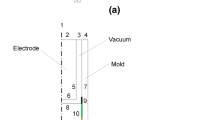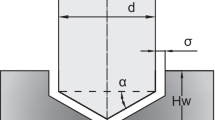Abstract
To improve the stability and technological index for deep hole machining by electrical discharge machining (EDM), this study proposed a hole machining method that employs continuous flushing and intermittent oxygen feeding (i.e., inner jetted aerosol dielectric ablation). Aerosol, a mixture generated by oxygen and water, was used as the discharge dielectric when the oxygen was supplied. The released chemical energy was used to improve the efficiency of deep hole machining during the machining of ablation. The ablation surface was trimmed by EDM at the anaerobic stage. A comparative test for inner jetted aerosol dielectric ablation, inner jetted dielectric EDM, and intermittent EDM ablation in pure oxygen (designated as intermittent EDM ablation) was performed in deep hole machining. In this paper, we studied the mechanism, machining efficiency, electrode relative wear ratio, and machining quality and accuracy. The energy of intermittent EDM ablation was excessively high that it cannot be easily controlled. The erosion products blocked the inner hole of electrode during machining. This phenomenon prevented oxygen from entering the machining region and induced short-circuit occurred, thereby causing the instability of deep hole machining. Inner jetted aerosol dielectric ablation can effectively control the degree of ablation and stabilize the process. The hole with a side length of 4.4 mm can be machined successfully, and its depth can reach more than 70 mm under the experimental conditions. The machining efficiency was 5.45 times that of the inner jetted dielectric EDM, and the relative tool wear ratio decreased by 82 %. Overall, the process showed excellent surface quality and high machining accuracy.
Similar content being viewed by others
References
Liu ZD (2013) Nontraditional machining. Peking University Press, Beijing
Kunieda M, Yoshida M, Taniguchi N (1997) Electrical discharge machining in gas. CIRP Ann Manuf Technol 46(1):143–146
Li LQ, Wang ZL, Zhao WS (2004) Mechanism analysis of electrical discharge machining in gas. J Harbin Inst Technol 36(3):359–362
Tanimura T, Isuzugawa K, Fujita I, Iwamoto A, Kamitani T (1989) Development of EDM in the mist. Proc ISEM 9:313–316
Gu L, Zhao WS, Zhang ZH, Kang XM (2006) Mist-jetting-ED-milling and its mechanism. Electromachin Mould 2:1–4
Wang XZ, Liu ZD, Xue RY, Tian ZJ, Huang YH (2013) Research on self-mixed oxygen in discharge gap to improve the processing characteristics of titanium alloy electrical discharge machining. Acta Aeronaut Astronaut Sin 34:2419–2426
Wang X, Liu Z, Qiu M, Hui Z, Tian Z, Huang Y (2014) Mechanism of electrical discharge machining ablation. Mater Manuf Process 29(11–12):1367–1373
Zabel A (2014) Deep hole drilling with small diameters. In: CIRP Encyclopedia of Production Engineering. Springer Berlin Heidelberg, pp 371-379
Kuppan P, Rajadurai A, Narayanan S (2008) Influence of EDM process parameters in deep hole drilling of Inconel 718. Int J Adv Manuf Technol 38(1–2):74–84
Wang X, Liu Z, Xue R, Tian Z, Huang Y (2014) Research on the influence of dielectric characteristics on the EDM of titanium alloy. Int J Adv Manuf Technol 72(5–8):979–987
Zhang MH (1989) Theoretical basis of EDM. National Defence Industry Press, Beijing
An QL (2006) The application of cryogenic pneumatic mist jet impinging in mechanical machining of titanium alloy. University of Aeronautics and Astromantics
Tzeng YF, Lee CY (2001) Effects of powder characteristics on electrodischarge machining efficiency. Int J Adv Manuf Technol 17(8):586–592
Murray J, Zdebski D, Clare A (2012) Workpiece debris deposition on tool electrodes and secondary discharge phenomena in micro-EDM. Mater Process Technol 212(7):1537–1547
Zhang XY, Liang R (2006) The influence of the discharge gap upon the machining quality for EDM. J Shaanxi Univ Sci Technol 05:96–99
Author information
Authors and Affiliations
Corresponding author
Rights and permissions
About this article
Cite this article
Cao, Z., Liu, Z., Ling, J. et al. Deep-type hole machining by inner jetted aerosol dielectric ablation. Int J Adv Manuf Technol 78, 1989–1998 (2015). https://doi.org/10.1007/s00170-014-6773-8
Received:
Accepted:
Published:
Issue Date:
DOI: https://doi.org/10.1007/s00170-014-6773-8




